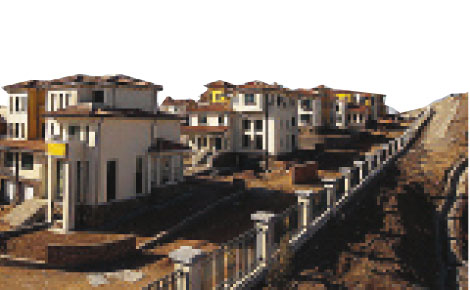By Lydia Limbe
Kenya: And As Machakos County Governor Alfred Mutua talks big about the investment opportunities that come with building a city, Home and Away takes a look at some cities around the world that were built with the same vision but have failed to take off for various reasons.
Build it and they will come, or so these developers thought, but this remains an unrealised dream.
Angola
The China International Trust and Investment Corporation built a 750 block of eight storied flats 30 kilometers from Luanda, the capital of Angola, and were meant to house 500,000 people. This credit extended by the Chinese government was to be paid by the Angolan government with oil exports to China.
This project, which was called Nova Cidade de Kilamba cost $3.5 billion Euros (Sh301 billion today) and was built on 12,355 acres of land. It is one of the biggest newly built projects in Africa and it took three years to complete the project.
The project was completed in 2012, with the first batch of 2,800 houses selling at 130,000 Euros (Sh15.34 million) against a rural poor who earn a minimum of about Sh182 per day. It has 7,100 shops units and a dozen schools, car parking and gaming areas for football, basketball and handball.
Only 220 units sold during the first release. The Angolan president, Jose Eduardo dos Santos during had pledged to build a million homes in four years, passed a new legislation that has seen the property market rise again.
As of September 2013, the current population of residents at this new city not far away from the capital City of Angola is at 40,000 and is expected to grow to 70,000 by end of January 2014.
Spain
In Spain, towering apartments targeted at 30,000 young Spanish couples are lying idle in Sesena, some 80 kilometers south of Madrid.
It has been dubbed ‘Manhattan of Madrid’ for these towering apartments.
Of the 13,000 homes that were built, with only 5,100 houses completed before the Spanish property bubble in 2007. This was meant to be Europe’s largest residential complex built by a single developer, 9 billion Euros (Sh1.06 trillion) of private money.
The property developer, Francisco Hernando, was meant to profit 1.5 Euros billion (Sh177 billion) from the project. His holding in Sesena has been repossessed by the banks that backed him and he has moved on to new dreams in greener pastures. He is now working on a plan to build 40,000 homes in the oil-rich state of Equatorial Guinea.
Today, most of Sesena’s apartments are unoccupied and tracts of the site are just baked earth, roads to nowhere and deep concrete holes in the ground.
Stay informed. Subscribe to our newsletter
The apartments bought by the Spaniards in 2007 for 200,000 Euros (Sh23.6 million) are largely unoccupied, with homeowners competing to offload them for huge losses at 65,000 Euros (Sh7.6 million).
The unattractive, prison-like architecture of the town stands starkly in an empty landscape of toll motorways, retail warehouses, farmland and a colossal mountain of second-hand car tyres. The city has no high school, no medical clinic and no bus service. But it does have a park named after Hernando’s wife and a vandalised statue of his parents in bronze on the city’s central roundabout.
The massive project raised eyebrows from the outset since it was discovered that the early plans for the community did not include connecting it to water or gas supplies. The former local mayor, José Luis Martín approved plans for the site on his last day in office and explained away the 700,000 Euros (Sh82.6 million) in his bank account as ‘lottery winnings’.
Ireland
Fifteen luxury grass-thatched roof cottages targeting the high-end clientele in St. James Wood Estate in the village of Stradbally, Ireland is now a thicket of overgrown weeds.
They were initially selling off at £800,000 (Sh112 million), but the asking price was at £200,000 (Sh28 million) — less than half the starting asking price.
Intended to be idyllic cottages, the property were launched in 2006. The developer went to great lengths to on the quality of finish of these homes.
Pat McCoy, the property developer, is reported as saying that he missed the market because he’d applied for tax breaks — a process that usually takes four months.
China
China is probably the most notorious for building ghost cities. One Ordos, built in was meant as home for one million people, the Kangbashi district remains nearly empty five years after construction began
Then there sis the world’s largest mall, also in China, and you guessed it also a ghost city. The New South China Mall in Dongguan has 7,100,000 square feet of leasable space and is 9,600,000 square feet in total area with 2,350 stores. 99 percent of this massive space has been vacant since 2005. With an anticipated traffic of 100,000 visitors a day, this construction cost the developer $402 (Sh34.5 billion).
The land that this mall was built was formally agricultural land in the Wanjiang District of the city with a population in excess of 10 million people. This project was spearheaded by Hu Guirong (Alex Hu) who became billionaire in the instant noodle industry boom.
It has seven zones modelled on international cities, nations and regions. These include: Amsterdam, Paris, Rome, Venice, Egypt, the Caribbean and California. More specifically, the features found within this massive concrete desert include 25 meters replica of Arc de Triomphe de I’Eitoile (one of the famous towers in Paris), St. Marks Campanile (a famous bell tower which is a symbol of Venice, Italy), a 2.1 kilometer canal with ganolas, a 553 meter indoor-outdoor roller coaster and the first licensed Teletubby Park.
Located in the suburbs of Dongguan, it’s only accessible by bus or car, rendering it unreachable by a large percentage of the public Chinese public. There’s no airport or highways near the mall’s location.
[email protected]
 The Standard Group Plc is a
multi-media organization with investments in media platforms spanning newspaper
print operations, television, radio broadcasting, digital and online services. The
Standard Group is recognized as a leading multi-media house in Kenya with a key
influence in matters of national and international interest.
The Standard Group Plc is a
multi-media organization with investments in media platforms spanning newspaper
print operations, television, radio broadcasting, digital and online services. The
Standard Group is recognized as a leading multi-media house in Kenya with a key
influence in matters of national and international interest.
 The Standard Group Plc is a
multi-media organization with investments in media platforms spanning newspaper
print operations, television, radio broadcasting, digital and online services. The
Standard Group is recognized as a leading multi-media house in Kenya with a key
influence in matters of national and international interest.
The Standard Group Plc is a
multi-media organization with investments in media platforms spanning newspaper
print operations, television, radio broadcasting, digital and online services. The
Standard Group is recognized as a leading multi-media house in Kenya with a key
influence in matters of national and international interest.









